Citing in APA Essay Format: The Key to Academic Writing Success
![Generic essay format says, there are just three arbitrary segments viz. introduction, body, and conclusion. But, you may not know that referencing and citing sources are one integral segment of any essay. In most instances, universities are found asking for APA formatting. Hence, it’s essential to get conversant with the citation rules, from the American Psychological Association to prepare a good quality draft. And, you are at the right place to be in, as this blog serves the platter of rubrics, illustrating every practical detail. Types of citation in APA essay format Crediting sources does not mean listing the names at the end. There are variations in styles and types, definitions and outlines, etc. Particularly, APA essay format highlights three different means of quoting a source. Here are they – In-text citation Parenthetical citation References This referencing style comes into action when the author’s name is mentioned in your paraphrased text. If the original creators’ name is NOT mentioned in the paraphrased line/passage, the parenthetical citation is used. It comes at the end where rest of all the sources, having a significant or insignificant contribution in your essay, are listed in a definite order. Considerable tips on APA referencing American Psychological Association coheres quite a number of protocols with APA referencing, and violation of any will badly reflect in your essay grades. Before you begin to create the “Reference” section in your essay, take a close look at these significant tips. In APA format, the bibliography section is titled as “References” Your references should begin from a new page Align the title of the page at the top-center There should be a 1-inch margin on all sides of the paper Don’t forget to insert the running title and the page count Each source must be arranged in an alphabetical order Set the font name as “Times New Roman” and the font size “12” Maintain double-spacing in between lines and keep the letters un-bold How to credit various sources in your “APA Reference”? Citation styles differ with the sources i.e. the way you will credit a book is not identical to a journal or online mag. For your easy understanding, here are some APA citation examples that will clear the concept a little further. Printed Books Last name of author, F. M. (Publish year). Book Title. Publisher Cite, State: Publisher name. Chapter in Print Books Author’s last name, F. M. (Publish Year). Chapter Title. Initial of F. M. Editor (Ed.), Book Title (pp. xx-xxx). Publisher City, State: Publisher. E-Books Last name, In F. M. (Publication Year). Title of work [E-reader version]. Retrieved from URL Chapter in E-Books Last name, In F. M. (Publish Year). Chapter Title. In of F. M. Editor (Ed.), Book Title [E-reader version] (pp. xx-xxx). Hhttp://abcc.efg.org/xxx or Retrieved from URL Journals of Online Database Last name, F. M. (Year of Publication). Title of Article. Journal Title, Volume number(Issue number), pp.-pp. homepage URL Imprinted Journals Last name, In F. M. (publication year). Article Title. Title of the Journal, Volume number(Issue number), pages. Online Magazines Last name, In F. M. (publication year, month). Article Title. Magazine Name, Volume number(Issue number), Retrieved from homepage URL or DOI no. Hardcopy Magazines Last name, In F. M. (publication year, month). Article Title. Magazine Name, Volume number(Issue number), page range. Blogs Last name, F.M. (publish year, month, day). Blog Title [Blog post]. Retrieved from website URL Websites (having authors) Last name of author, In. F.M. (publish year, month day). Website name [Format]. Retrieved from URL Websites (without authors) Title of the webpage [Format]. (year of publication, month day) Retrieved from webpage URL How to perform parenthetical and in-text citation? Many times, student quotes from other’s work in their essays to justify an explanation or to maintain the collateral relation between the two creations. Taking a close look at the veritable APA formatted paper, you will understand this fact. However, whatever be the reason, it’s important to credit the source and these citations are done within the body, not in the “Reference” section. Between the last word of the paraphrased text and the period, cite the source. Take a look at the samples to understand how to do the said – In-text citation (where the author’s name is already mentioned) Paraphrased text (year of publication). Parenthetical citation (where the author’s name is NOT mentioned) Paraphrased text (Last name of the author, year of publication). If there are two authors: Paraphrased text (Author 1 & Author 2, year of publication). If there are three or more authors : Paraphrased text (Author 1 et al. year of publication) With this ends the APA citation rules. Try to abide by these guidelines while preparing your draft. It will ensure shining grades with a lot of appreciation. Having more difficulties? Even after knowing all the instructions, some fails to develop an ideal essay. The reason can deadline, the complexity of the topic, or something else. If that’s the scenario with you, quickly get in touch with a professional writing service who write papers for college students. You can consider PenMyPaper for your essay help – presently, a significant contender for the top position. It has an adroit team of writers and proofreaders, who toils with proficiency, and ascertains that the essays preserve the finest quality. Visit the website for more information.](https://penmypaper.com/blog/wp-content/uploads/2019/04/How-to-Cite-In-APA-Essay-Format-Learn-From-Sample-References.png)
Quick Navigation
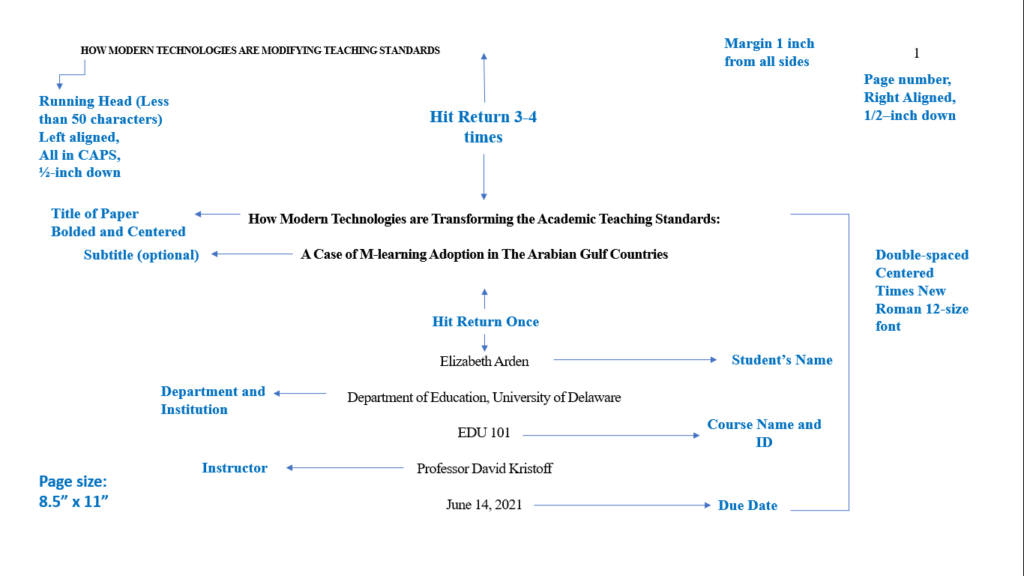
In the realm of academic writing, adhering to specific formatting is important. The American Psychological Association (APA) essay format is one such standardized style that has become widely adopted in various disciplines. Whether you are an experienced scholar or a student embarking on your academic journey, understanding the APA essay format is essential for crafting well-structured and credible essays. In this exhaustive guide, the professionals of our essay writing website will delve into the intricacies of the APA essay format, providing you with valuable insights and tips to excel in your academic pursuits. We will guide you through the fundamental principles of APA style, from in-text citations to reference lists, ensuring that you understand the importance of giving credit to the original authors and avoiding plagiarism.
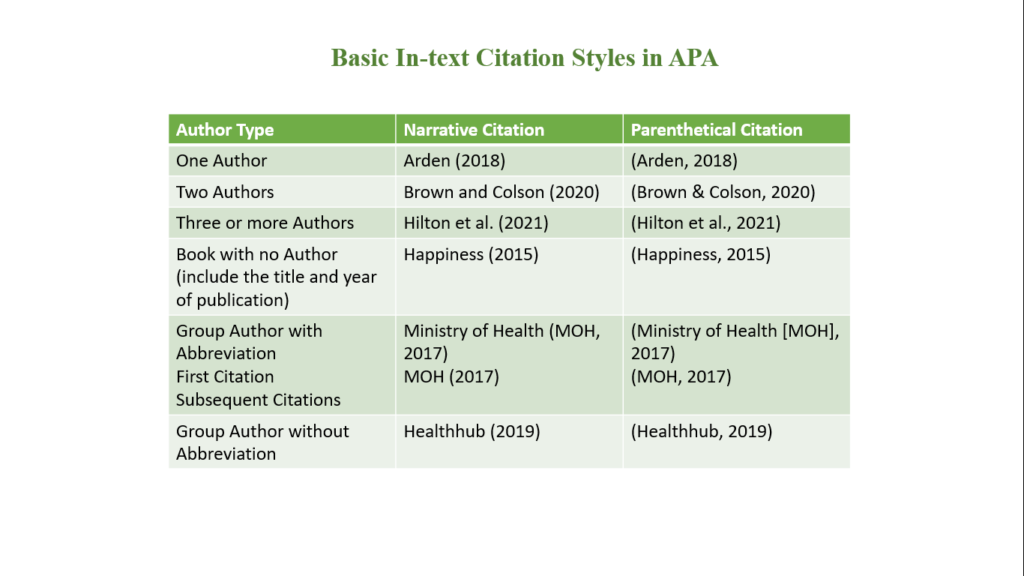
Types of Citations in APA Essay Format
In-text Citations
In-text citations are used within the body of the essay to give credit to the sources consulted. They provide brief information about the source and allow readers to locate the whole reference in the Reference list. In APA format, there are two main types of in-text citations: narrative and parenthetical.
a. Narrative In-text Citations:
Narrative in-text citations involve incorporating the author’s name into the sentence itself, followed by the publication year in parentheses. This format is typically used when the author’s name is an integral part of the sentence. Examples:
According to Johnson (2019), the study revealed significant results.
In the research conducted by Smith and Brown (2020), it was found that…
b. Parenthetical In-text Citations:
Parenthetical in-text citations are enclosed within parentheses and include the author’s name and publication year. This format is used when the author’s name is not explicitly mentioned in the sentence. Examples:
The impact of climate change is a pressing global concern (Smith, 2019).
Recent studies have shown conflicting results (Johnson & Brown, 2020).
Note: For direct quotations, page numbers should be included after the publication year.
References
The reference list is a separate section at the end of your essay that provides complete details about the sources you have cited in your paper. Each entry in the reference list includes essential information to allow readers to locate and verify the sources.
The APA referencing style for entries varies depending on the type of source. Here are some common types of sources and their reference formats:
| Books: Author Surname, F. M. (Publication Year). Title of the book. Publisher. |
| Journal Articles: Author, A. A., Author, B. B., & Author, C. C. (Year). Title of article. Title of Journal, Volume (Issue), Page range. DOI or URL |
| Websites: Author or Name of Organization. (Year, Month Day of Publication). Title of webpage/document. Site Name. URL |
| Newspaper: Author Surname, (Publication Date). Title of the article. Newspaper Title or Magazine Title. URL |
| Online Scholarly Journal Articles with a Digital Object Identifier (DOI): Author, A. A., & Author, B. B. (Year). Title of article. Title of Journal, Volume (Issue), Page range. DOI |
| YouTube Video: Uploader’s Name, F. (Year, Month Day of Publication). Title of the Video. YouTube. URL |
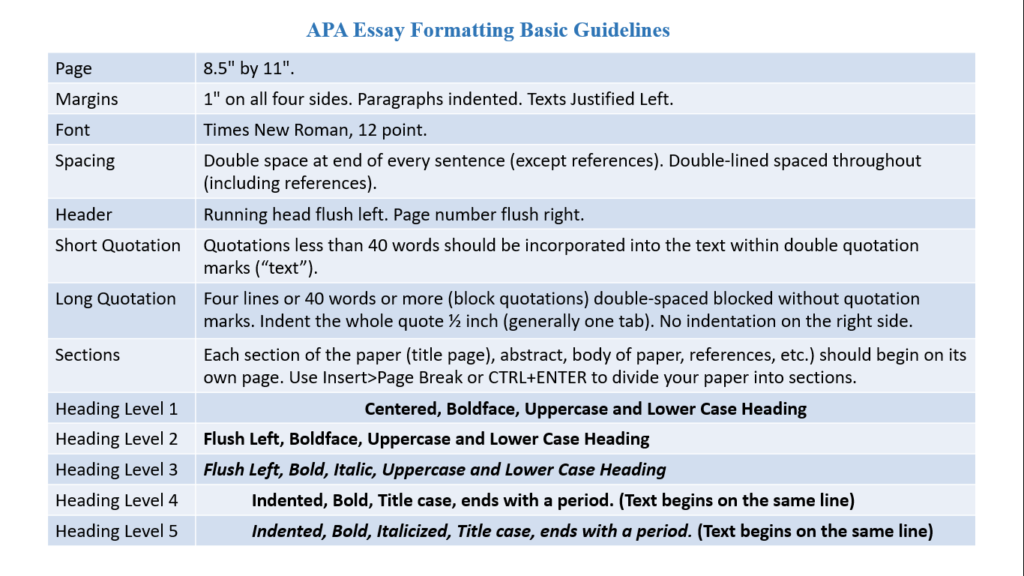
Formatting Guidelines for APA Essays
Following are the guidelines to consider when writing an APA format paper.
A. Margins, Spacing, and Font:
Set margins to 1 inch on all sides of the paper.
Use double-spacing throughout the entire document, including the title page, abstract, main body, and reference list.
Use a legible font such as Times New Roman or Arial, with a font size of 12 points.
B. Title Page Specifications:
Include a running head at the top left of the page. The running head is a shortened version of the title and should not exceed 50 characters, including spaces.
On the same line as the running head, align to the right and include the page number.
Center the full title of your essay in the middle of the page. It should be concise, descriptive, and no more than 12 words.
Beneath the title, list the author’s name and institutional affiliation (e.g., university or organization).
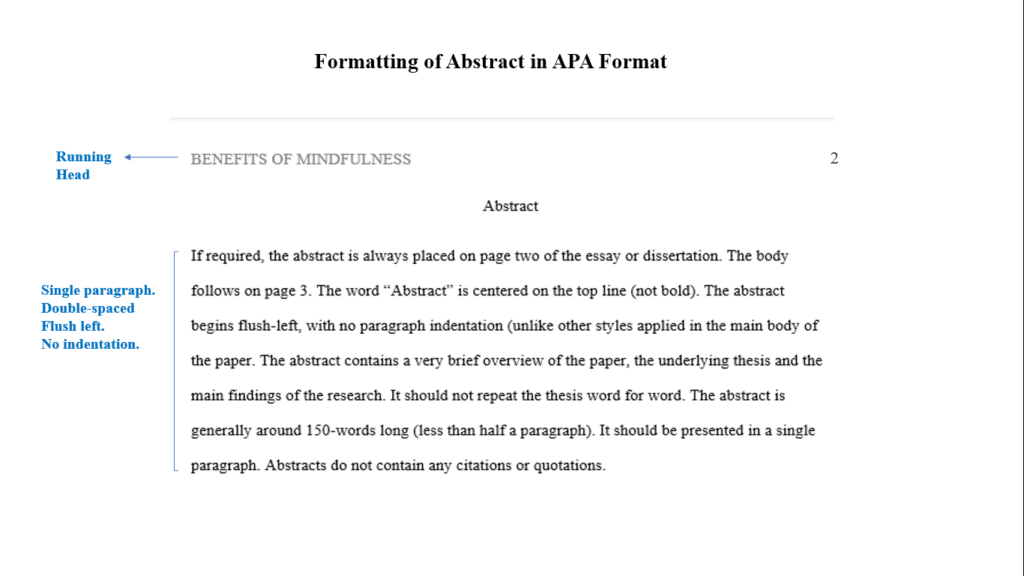
C. Abstract Requirements:
Begin on a new page after the title page.
Center the word “Abstract” at the top of the page, in bold and italics.
Write a concise summary of your essay, typically between 150 and 250 words.
Avoid citing references or including detailed information in the abstract.
Place keywords related to your essay at the end of the abstract.
D. Heading Levels and Subheadings:
Use heading levels to organize the structure of your essay.
The main sections (e.g., Introduction, Methods, Results, Conclusion) are Level 1 headings, aligned to the left and in bold.
Subsections within the main sections are Level 2 headings, aligned to the left and in bold.
If necessary, additional subsections can be Level 3 headings, indented, bold, and ending with a period.
Each level of heading should have clear differentiation in formatting.
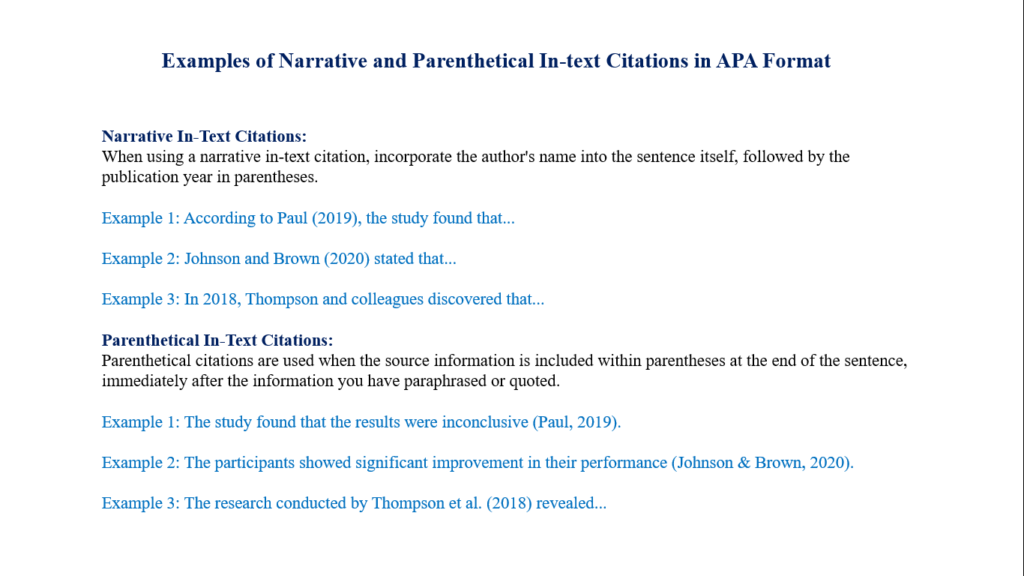
E. In-Text Citations:
Use in-text citations to acknowledge the sources consulted within your essay.
Include the author’s last name and the publication year in parentheses.
Place in-text citations immediately after the cited information.
For direct quotations, include the page number after the publication year, preceded by “p.” or “pp.”
F. Reference List:
Begin the reference list on a new page after the main body of your essay.
The reference list should be titled “References” and positioned at the top of the page. It should be centered and formatted in bold.
Each in-text citation must be accompanied by a corresponding entry in the reference list.
The entire reference list should be double-spaced.
Entries in the reference list should be organized alphabetically based on the authors’ last names or the first item in the entry.
Each source in the reference list should have a hanging indent, where the second line of each entry is indented ½ inch from the left margin.
The author’s middle name and first name should be included as initials in the reference entry.
For longer works such as books or names of newspapers, they should be italicized in the reference entry.
G. Tables and Figures:
Include tables and figures as necessary to support your essay.
Number tables and figures consecutively in the order they appear in the essay (e.g., Table 1, Figure 1).
Provide a brief but descriptive title for each table and figure.
Include a source note below the table or figure, if applicable.
Reference each table and figure within the main body of your essay.
Adhering to these formatting guidelines ensures consistency and enhances the readability of your APA essay. Remember to consult the APA Publication Manual or the APA Style website for further details and specific formatting instructions.
Since we are discussing APA format, it will also be beneficial for you to go through MLA format citations as well.
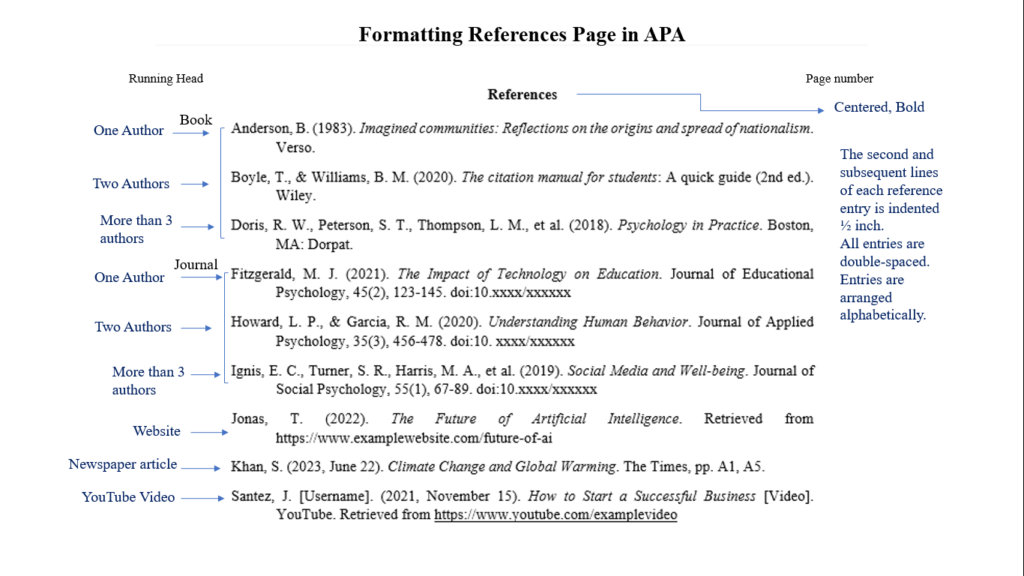
Reference Entries for Different Numbers of Authors
The number of authors in a source determines how the author names are formatted in the reference list. Below, you will find several examples of journal references with varying numbers of authors.
One author
| Format: Author’s Last Name, Author’s First Initial. (Publication Year). Article Title: Subtitle. Journal Title, Volume (Issue), Page Range. |
| Example: Johnson, M. (2019). The impact of climate change on biodiversity. Environmental Studies Journal, 15(2), 67-82. |
Two authors
| Format: Author 1’s Last Name, Author 1’s First Initial., & Author 2’s Last Name, Author 2’s First Initial. (Publication Year). Article Title: Subtitle. Title of Journal, Volume (Issue), Page Range. DOI or URL |
| Example: Garcia, A., & Martinez, S. (2020). Exploring the effects of social media on self-esteem. Journal of Social Psychology, 27(4), 123-139. https://doi:10.1080/01425699995441 |
Three to twenty authors
| Format: Author 1’s Last Name, Author 1’s First Initial., Author 2’s Last Name, Author 2’s First Initial., & Author 3’s Last Name, Author 3’s First Initial. (Publication Year). Article Title: Subtitle. Journal Title, Volume (Issue), Page Range. DOI or URL |
| Example: Smith, J., Adams, R., Collins, M., Turner, L., Walker, K., Roberts, P., Wilson, D., Harris, B., Thompson, A., Parker, L., Hall, E., Johnson, C., Lee, M., Lewis, H., Martin, G., Phillips, R., Robinson, S., Turner, A., Watson, N., & Young, P. (2018). The role of family support in child development. Journal of Child Psychology, 42(3), 201-215. https://doi:10.1080/1600910X.2017.1331931 |
More than twenty authors
| Format: Author 1’s Last Name, Author 1’s First Initial., Author 2’s Last Name, Author 2’s First Initial., Author 3’s Last Name, Author 3’s First Initial., … Author 19’s Last Name, Author 19’s First Initial., Last Author’s Last Name, Last Author’s First Initial. (Publication Year). Article Title: Subtitle. Title of Journal, Volume (Issue), Page Range. DOI or URL |
| Example: Anderson, T., Baker, P., Clark, R., Davis, E., Evans, F., Garcia, M., Seng, A. L., Sevel, K., Ed, E., Nell, A., Ten, T., Elin, K. J., Thomas, A., Thendy, S., Fall, W., Fint, E., Gurdy, A. K., Dondy, D., Egert, E., Nanda, A. L., … Young, R. (2022). The future of renewable energy: A comprehensive analysis. Journal of Environmental Studies, 35(1), 57-72. |
When two organizations are listed as authors, omit the comma before the ampersand.
Example:
American Psychological Association & American Psychological Society. (2020). Psychology of Children. Journal of Child Psychology, 16(23), 1–12.
Please note that these examples cover only a few scenarios. For other source types, such as books, websites, and more, refer to the APA Publication Manual or the APA Style website for specific guidelines.
With this full proof guidance on APA format paper, you should now have developed a solid understanding of the APA essay format.
Common Mistakes to Avoid in APA Essays
Writing an essay in APA format calls for attention to detail and adherence to specific guidelines. To ensure your essay is correct and follows the APA style appropriately, it’s essential to avoid common mistakes that can undermine the quality and credibility of your work. Here are five common mistakes to be mindful of:
A. Incorrect In-Text Citations and References
One of the most critical aspects of APA essays is accurate in-text citations and corresponding references. Mistakes in citing sources can lead to plagiarism or improper attribution. Make sure to use the correct format for in-text citations, including the author’s last name and the publication year. Similarly, ensure that the reference list entries are complete and follow the prescribed format for different source types.
B. Improper Formatting and Styling
Improper formatting and styling can detract from the professionalism of your essay. APA essays require specific guidelines for margins, spacing, font size, and indentation. Make sure to set appropriate margins (usually 1 inch), use double spacing throughout the document, and choose a legible font such as Times New Roman or Arial in 12-point size. Additionally, pay attention to the correct use of italics, capitalization, and punctuation in headings, titles, and references.
C. Plagiarism and Ethical Considerations
Plagiarism is a serious offense in academic writing. It is crucial to properly attribute ideas, concepts, and direct quotes to their sources. Failing to cite sources or paraphrase without giving credit can lead to severe consequences. Familiarize yourself with APA guidelines for citing sources and use quotation marks or appropriate paraphrasing techniques to avoid plagiarism. Additionally, be aware of ethical considerations when conducting research involving human subjects and ensure proper acknowledgment and protection of their rights.
D. Inconsistencies in Headings and Subheadings
APA essays utilize a hierarchical system of headings and subheadings to organize content. Inconsistencies in the formatting and structure of headings can confuse readers and undermine the clarity of your essay. Use consistent formatting for each level of heading, including font style, capitalization, and alignment. Ensure that headings are properly nested and reflect the logical structure of your essay.
E. Neglecting the Abstract
The abstract is an essential component of APA essays, providing a concise summary of the main points and purpose of your research. Neglecting to include an abstract or not following the required format can be detrimental to your essay. The abstract should be a single paragraph, between 150 to 250 words, and placed on a separate page immediately after the title page. It should summarize the key elements of your essay, including the research question, methods, results, and conclusions.
You will be able to enhance the quality and professionalism of your APA essay by avoiding these mistakes. Bear in mind to carefully review and proofread your work for ensuring accuracy and adherence to the APA guidelines.
Need Further Help?
Mastering the APA essay format is an essential skill that empowers individuals to communicate their ideas effectively and present their research in a standardized and professional manner. By adhering to the APA guidelines outlined in this comprehensive guide, you will enhance the credibility and readability of your essays, ensuring that your work is respected within the academic community. For further assistance, you can pay essay easily at our platform to get well-written essay by professionals.
Remember, mastering the APA essay format is a journey, and this guide serves as a valuable resource to assist you along the way. With a solid understanding of the guidelines and a commitment to meticulous attention to detail, you will be well on your way to producing exceptional essays that showcase your academic prowess.
Our aim for this article is to serve as a guide to help you with how to write a dissertation effectively in APA format. If you encounter challenges in adhering to the guidelines provided, our team of experts is available to assist you. Feel free to reach out to us for the necessary support you need.

